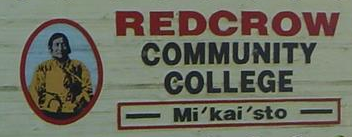Niitsikapa’s – Perideridia gairdneri (Hook. & Arn.) Mathias (Squaw root; Double turnip)
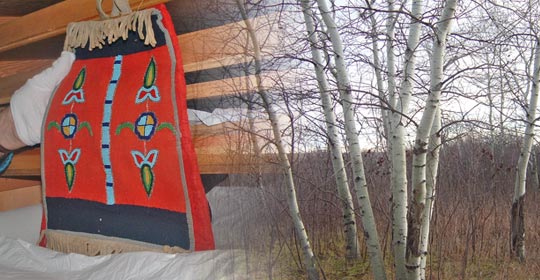
A decorative art piece from the Glenbow Museum.
Yampa can often be found in areas where the Poplar trees grow.
(Glenbow Museum. (2005). Nitsitapiisinni Exhibit.
Calgary, Alberta: Blackfoot Gallery Committee)
Niitsikapa’s
Niitsikapa’s iitaottssatssaiskiiw spahkoistsi,ki atsowa’sskoistsi otsitotsikahkohpi. Amo ni’nsimaan iimataittsinihka, iikstawa’pssop sakioohtsitaohkoonimao’s Kainaisksaahko. Iikohtakaomianistohtaisaamsko’p. Ihtaiksikka’pistotsi’p koistominnoonistsi. I’kamsto’soki,i’kamaistsohksistonio’ki ki i’kamiiyikkssaiskinio’ki akohkottohtsiksistsikimisstao’p. Aakatohkotawanstsi’p akitohtssawatssaiskinio’p ki ahkitssawatsisttsohksistonio’p. Niitsikapa’s iikattsitapssoka’pi ponokaomitaiksi.
Yampa
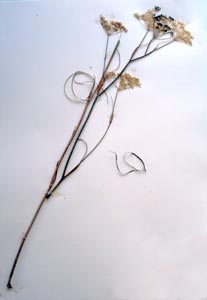
Perideridia gairdneri (Hook. & Arn.) Mathias
Galileo Educational Network
Yampa is a plant that grows on the moist edges of open hillsides, meadows and woodlands. It grows to be about 30-60 cm high and there are white flowers at the top of the plant. If you walk by it, you might think that the bunch of flowers look like upside down umbrellas. The root of the plant is the really important part and when you dig it up it looks like two little peanuts. This plant is on the endangered species list in many areas, but luckily for us,it is still plentiful on the Kainai Reserve.
The roots of yampa can be made into many medicines. One of the big healing things it does for your body is that it helps you get rid of things that might be making you sick. If you eat a bunch of the roots, they work as both a laxative and as a diuretic. It helps your liver, bladder and intestines to detoxify. You can make a tea of the roots and you massage it on a sore area of your body. Then if you place a heating pad (our elders long ago used hot rocks) on top of where you massaged in the yampa tea, it helps to draw out of your body what is making you so sore.
You can make a smudge of the root and breath it in, with a blanket or a towel over your head, and it helps with really bad coughs or coughs that you have had for a while. For a cough or sore throat, you can make a tea of the roots or just suck on the roots and it makes you feel better. You can also use the tea to squirt in your nostrils and it will help unplug your nose.
Our elders used it for medicine for horses, too. In the same ways; to help horses with liver or bladder troubles and for horses with colds or stuffy noses.
Scientists have figured out something about yampa that our elders knew long ago. Yampa has a lot of carbohydrates. That is something our body uses to give us energy. Yampa is special because our body can turn it quickly from food into energy. Buffalo runners would chew yampa just like we might eat an energy bar when we are exercising. Yampa was also given to racehorses to help them have lots of energy too.
Yampa was an important staple food for our elders. If you are out on the praire just dig up the roots for a snack. You can boil them and eat them like a vegetable or put them in soups, with fat or blood. You can also dry them for later on.
Besides medicine and food, our elders used the yampa plant to waterproof a skin bag or to shine up arrowheads.
Perideridia gairdneri
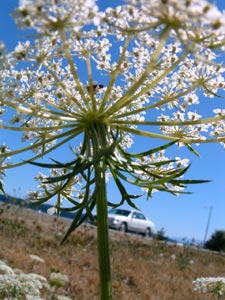
Perideridia gairdneri (Hook. & Arn.) Mathias
Galileo Educational Network
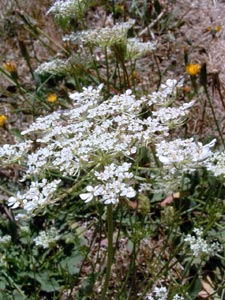
Perideridia gairdneri (Hook. & Arn.) Mathias
Galileo Educational Network
- Hellson, John C. (1974). Ethnobotany of the Blackfoot Indians. Ottawa: National Museums of Canada.
- Kerik, Joan. (1979). Living With The Land: Use of Plants by the Native People Of Alberta. Edmonton, Alberta: Provincial Museum of Alberta.
- Moerman, Daniel E. (1998). Native American Ethnobotany. Portland: Timber Press.
- Tilford, Gregory. (1997). Edible and Medicinal Plants Of The West. Missoula, Montana: Mountain Press Publishing Company.
- Willard, Terry. (1992). Edible and Medicinal Plants of the Rocky Mountains and Neighboring Territories. Calgary, Alberta: Wildrose College of Natural Healing.



